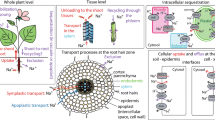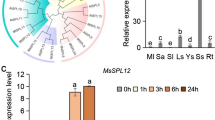Abstract
A full-length cDNA clone encoding an 866 bp-length glutathione peroxidase protein (NnGPX) was isolated from lotus (Nelumbo nucifera L.). The deduced amino acid sequence of the NnGPX gene had significant homology with ATGPX6. A 3D structural model of the NnGPX was constructed by homology modeling. The cloned NnGPX gene was expressed in Escherichia coli, and a fusion protein of about 40 kDa was detected after isopropyl thiogalactoside induction. Under different concentrations of Na2SeO3 treatments, NnGPX was found to be an enzyme that does not contain selenium. Real-time PCR analysis showed that the NnGPX gene was expressed in all organs of lotus, and its high expression mainly occurred in organs with active metabolisms. NnGPX transcript increased remarkably in response to cold, heat, mechanical damage, and salt treatment. Subsequently, the NnGPX gene was introduced in Oryza sativa cv. Yuetai B. PCR results verified the integration of this gene into the genome of rice and reverse transcription-PCR verified that this gene had been expressed in transgenic rice. The transgenic plants were significantly more tolerant to salt stress compared with the wild-type.










Similar content being viewed by others
References
Bowler C, Montagu MV, Inze D (1992) Superoxide dismutase and stress tolerance. Annu Rev Plant Physiol Plant Mol Biol 4:83–116
Fink RC, Scandalios JG (2002) Molecular evolution and structure–function relationships of the superoxide dismutase gene families in angiosperms and their relationship to other eukaryotic and prokaryotic superoxide dismutases. Arch Biochem Biophys 399:19–36
Rotruck JT, Pope AL, Ganther HE, Swanson AB, Hafeman DG, Hoekstra WG (1973) Selenium: biochemical role as a component of glutathione peroxidases. Science 179:588–590
Stadman TC (1996) Selenocysteine. Annu Rev Biochem 65:83–100
David AP, Maarten AP (1982) Extreme longevity of lotus seeds from Pulantien. Nature 299:148–149
Ding YF, Cheng HY, Song SQ (2008) Changes in extreme high-temperature tolerance and activities of antioxidant enzymes of sacred lotus seeds. Sci China C Life Sci 51:842–853
Huang SZ, Tang XJ, Zhang L, Fu JR (2003) Thermotolerance and activity of antioxidative enzymes in lotus seeds. J Plant Physiol Mol Biol 29:421–424
Sujay R, Atul W, Kakali M, Bishnu PS, Pulok KM (2006) Antioxidant activity of Nelumbo nucifera (sacred lotus) seeds. J Ethnopharmacol 104:322–327
Li Y, Zhang Y, Wei S, Liu L, Chen Y (2012) Recovery of antioxidant gene expression in sacred lotus (Nelumbo nucifera Gaertn) embryonic axes enhances tolerance to extreme high temperature. Afr J Biotechnol 11:12011–12019
Dong C, Li GL, Li ZQ, Zhu HL, Zhou MQ, Hu ZL (2009) Molecular cloning and expression analysis of an Mn-SOD gene from Nelumbo nucifera. Appl Biochem Biotech 158:605–614
Dong C, Zheng XF, Li GL, Zhu HL, Zhou MQ, Hu ZL (2011) Molecular cloning and expression of two cytosolic copper-zinc superoxide dismutases genes from Nelumbo nucifera. Appl Biochem Biotechnol 163:679–691
Zheng ZL, Zuo ZY, Liu ZG, Tsai KC, Liu AF, Zou GL (2005) Construction of a 3D model of nattokinase, a novel fibrinolytic enzyme from Bacillus natto: a novel nucleophilic catalytic mechanism for nattokinase. J Mol Graph Model 23:373–380
Tamura K, Peterson D, Peterson N, Stecher G, Nei M, Kumar S (2011) MEGA5: molecular evolutionary genetics analysis using maximum likelihood, evolutionary distance, and maximum parsimony methods. Mol Biol Evol 28:2731–2739
Shen G, Pang Y, Wu W, Deng Z, Liu X, Lin J, Zhao L, Sun X, Tang K (2005) Molecular cloning, characterization and expression of a novel Asr gene from Ginkgo biloba. Plant Physiol Biochem 43:836–843
Livak KJ, Schmittgen TD (2001) Analysis of relative gene expression data using real-time quantitative PCR and the 2(–Delta Delta C(T)) method). Methods 25:402–408
Liu Y, Teng Z, Wang S, He G (2008) Effects of high temperature stress on soluble sugar and membrane protective enzyme of rice. J Southwest Uni 30:59–63
Zhang DZ, Wang PH, Zhao HX (1990) Determination of the content of free proline in wheat leaves. Plant Physiol Commun 94:462–465
Rogerio M, Christophe D, Felipe KT, Marcia MP (2008) Glutathione peroxidase family—an evolutionary overview. FEBS J 275:3959–3970
Lee PY, Kho CW, Lee H, Kang S, Lee SC, Park BC, Cho S, Bae KH, Park SG (2007) Glutathione peroxidase 3 of Saccharomyces cerevisiae suppresses non-enzymatic proteolysis of glutamine synthetase in an activity-independent manner. Biochem Biophys Res Comm 362:405–409
Utomo A, Jiang XZ, Furuta S, Yun J, Levin DS, Wang YCJ, Desai KV, Green JE, Chen PL, Lee WH (2004) Identification of a novel putative non-selenocysteine containing phospholipid hydroperoxide glutathione peroxidase (NPGPx) essential for alleviating oxidative stress generated from polyunsaturated fatty acids in breast cancer cells. J Biol Chem 279:43522–43529
Criqui MC, Jamet E, Parmentier Y, Marbach J, Durr A, Fleck J (1992) Isolation and characterization of a plant cDNA showing homology to animal glutathione peroxidases. Plant Mol Biol 18:623–627
Holland D, Ben-Hayyim G, Faltin Z, Camoin L, Strosberg AD, Eshdat Y (1993) Molecular characterization of salt-stress-associated protein in Citrus: protein and cDNA sequence homology to mammalian glutathione peroxidase. Plant Mol Biol 21:923–927
Sugimoto M, Sakamoto W (1997) Putative phospholipid hydroperoxide glutathione peroxidase gene from Arabidopsis thaliana induced by oxidative stress. Genes Genet Syst 72:306–311
Li WJ, Feng H, Fan JH, Zhang RQ, Zhao NM, Liu JY (2000) Molecular cloning and expression of a phospholipid hydroperoxide glutathione peroxidase homolog in Oryza sativa. Biochim Biophys Acta Gene Struct Expr 1493:225–230
Jung BG, Lee KO, Lee SS, Chi YH, Jang HH, Kang SS, Lee K, Lim D, Yoon SC, Yun DJ, Inoue Y, Cho MJ, Lee SY (2002) A Chinese cabbage cDNA with high sequence identity to phospholipid hydroperoxide glutathione peroxidases encodes a novel isoform of thioredoxin-dependent peroxidase. J Biol Chem 277:12572–12578
Nicolas N, Vale´rie C, Jose´ G, Eric G, Masakazu H, Pascal R, David BK, Emmanuelle Issakidis, Jean-Pierre Jacquot, Nicolas Rouhier (2006) Plant glutathione peroxidases are functional peroxiredoxins distributed in several subcellular compartments and regulated during biotic and abiotic stresses. Plant Physiol 142:1364–1379
Rocher C, Lalanne JL, Chaudiere J (1992) Purification and properties of a recombinant sulfur analog of murine selenium-glutathione peroxidase. Eur J Biochem 205:955–960
Roxas VP, Lodhi SA, Garrett DK, Mahan JR, Allen RD (2000) Stress tolerance in transgenic tobacco seedlings that overexpress glutathione S-transferase/glutathione peroxidase. Plant Cell Physiol 41:1229–1234
Milla M, Maurer A, Huete A, Gustafson J (2003) Glutathione peroxidase genes in Arabidopsis are ubiquitous and regulated by abiotic stresses through diverse signaling pathways. Plant J 36:602–615
Miao Y, Lv D, Wang P, Wang X, Chen J, Miao C, Song C (2006) An Arabidopsis glutathione peroxidase functions as both a redox transducer and a scavenger in abscisic acid and drought stress responses. Plant Cell 18:2749–2766
Acknowledgments
This research was supported by National Key Technologies R&D Program (No. 2012BAD27B01). The authors thank the anonymous referees for their critical comments that contributed toward improving this manuscript.
Author information
Authors and Affiliations
Corresponding authors
Additional information
Ying Diao and Huaxue Xu contributed equally to this work.
Rights and permissions
About this article
Cite this article
Diao, Y., Xu, H., Li, G. et al. Cloning a glutathione peroxidase gene from Nelumbo nucifera and enhanced salt tolerance by overexpressing in rice. Mol Biol Rep 41, 4919–4927 (2014). https://doi.org/10.1007/s11033-014-3358-4
Received:
Accepted:
Published:
Issue Date:
DOI: https://doi.org/10.1007/s11033-014-3358-4




